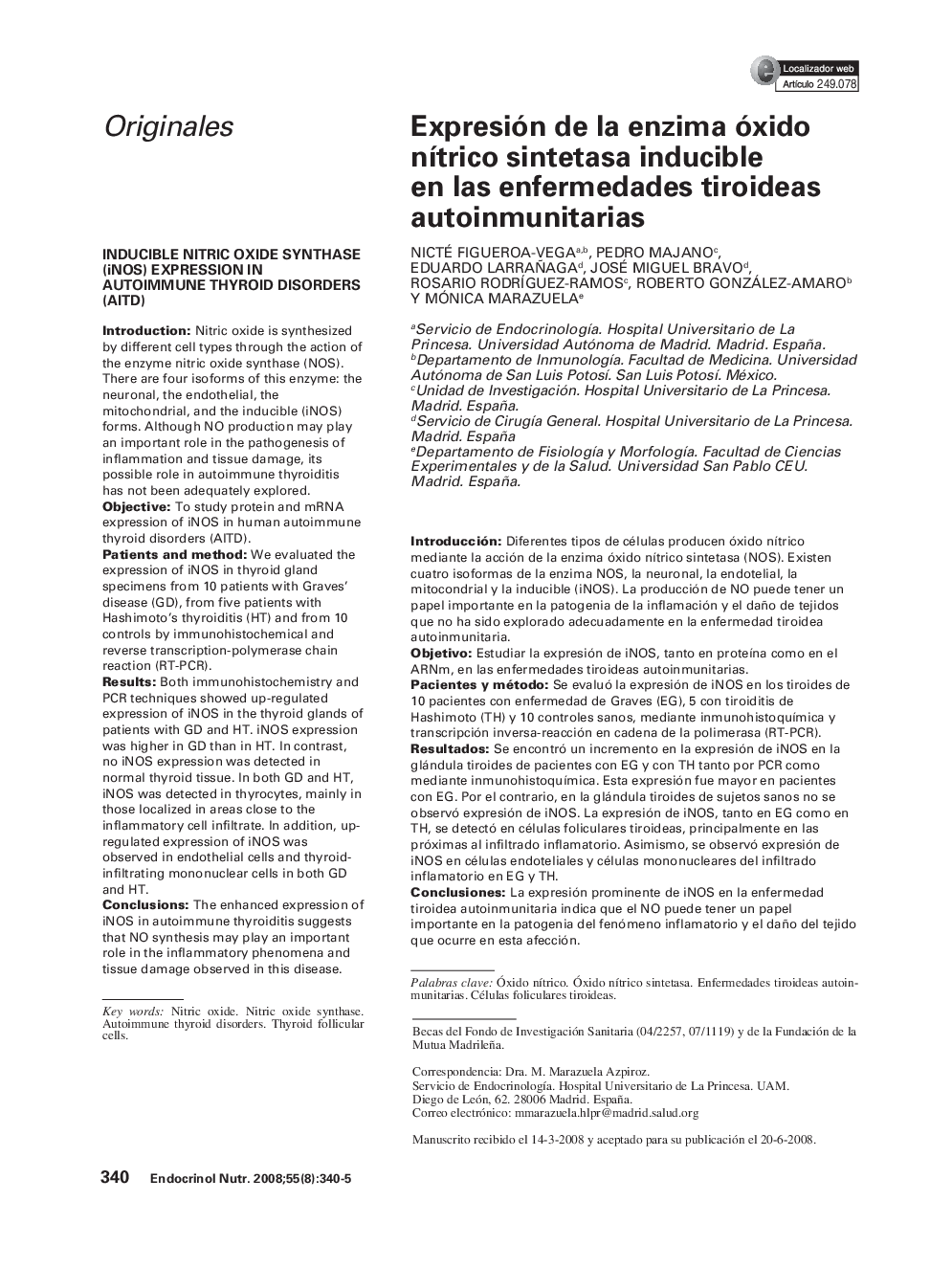| Article ID | Journal | Published Year | Pages | File Type |
|---|---|---|---|---|
| 2774481 | Endocrinología y Nutrición | 2008 | 6 Pages |
IntroducciónDiferentes tipos de células producen óxido nítrico mediante la acción de la enzima óxido nítrico sintetasa (NOS). Existen cuatro isoformas de la enzima NOS, la neuronal, la endotelial, la mitocondrial y la inducible (iNOS). La producción de NO puede tener un papel importante en la patogenia de la inflamación y el daño de tejidos que no ha sido explorado adecuadamente en la enfermedad tiroidea autoinmunitaria.ObjetivoEstudiar la expresión de iNOS, tanto en proteína como en el ARNm, en las enfermedades tiroideas autoinmunitarias.Pacientes y métodoSe evaluó la expresión de iNOS en los tiroides de 10 pacientes con enfermedad de Graves (EG), 5 con tiroiditis de Hashimoto (TH) y 10 controles sanos, mediante inmunohistoquímica y transcripción inversa-reacción en cadena de la polimerasa (RT-PCR).ResultadosSe encontró un incremento en la expresión de iNOS en la glándula tiroides de pacientes con EG y con TH tanto por PCR como mediante inmunohistoquímica. Esta expresión fue mayor en pacientes con EG. Por el contrario, en la glándula tiroides de sujetos sanos no se observó expresión de iNOS. La expresión de iNOS, tanto en EG como en TH, se detectó en células foliculares tiroideas, principalmente en las próximas al infiltrado inflamatorio. Asimismo, se observó expresión de iNOS en células endoteliales y células mononucleares del infiltrado inflamatorio en EG y TH.ConclusionesLa expresión prominente de iNOS en la enfermedad tiroidea autoinmunitaria indica que el NO puede tener un papel importante en la patogenia del fenómeno inflamatorio y el daño del tejido que ocurre en esta afección.
IntroductionNitric oxide is synthesized by different cell types through the action of the enzyme nitric oxide synthase (NOS). There are four isoforms of this enzyme: the neuronal, the endothelial, the mitochondrial, and the inducible (iNOS) forms. Although NO production may play an important role in the pathogenesis of inflammation and tissue damage, its possible role in autoimmune thyroiditis has not been adequately explored.ObjectiveTo study protein and mRNA expression of iNOS in human autoimmune thyroid disorders (AITD).Patients and methodWe evaluated the expression of iNOS in thyroid gland specimens from 10 patients with Graves’ disease (GD), from five patients with Hashimoto's thyroiditis (HT) and from 10 controls by immunohistochemical and reverse transcription-polymerase chain reaction (RT-PCR).ResultsBoth immunohistochemistry and PCR techniques showed up-regulated expression of iNOS in the thyroid glands of patients with GD and HT. iNOS expression was higher in GD than in HT. In contrast, no iNOS expression was detected in normal thyroid tissue. In both GD and HT, iNOS was detected in thyrocytes, mainly in those localized in areas close to the inflammatory cell infiltrate. In addition, upregulated expression of iNOS was observed in endothelial cells and thyroidinfiltrating mononuclear cells in both GD and HT.ConclusionsThe enhanced expression of iNOS in autoimmune thyroiditis suggests that NO synthesis may play an important role in the inflammatory phenomena and tissue damage observed in this disease.
